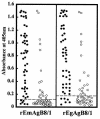Molecular cloning, expression, and serological evaluation of an 8-kilodalton subunit of antigen B from Echinococcus multilocularis
- PMID: 15004057
- PMCID: PMC356886
- DOI: 10.1128/JCM.42.3.1082-1088.2004
Molecular cloning, expression, and serological evaluation of an 8-kilodalton subunit of antigen B from Echinococcus multilocularis
Abstract
Full-length cDNA and genomic DNA encoding an 8-kDa subunit of antigen B from Echinococcus multilocularis (designated EmAgB8/1) were isolated from an E. multilocularis metacestode cDNA library and a protoscolex genomic DNA library, respectively. The open reading frame of the cDNA clone encodes a polypeptide comprising 85 amino acids with a 20-amino-acid NH(2)-terminal signal sequence, which was confirmed following N-terminal sequencing of the native antigen. Reverse transcription-PCR analysis revealed that the clone encoding EmAgB8/1 is predominantly transcribed in larval E. multilocularis. The gene consists of two exons (encoding the signal sequence and mature protein) separated by a 91-bp intron. The mature form was expressed in Escherichia coli, and its antigenic reactivity was compared with that of a counterpart, an 8-kDa subunit of antigen B from Echinococcus granulosus (EgAgB8/1) by Western blotting and enzyme-linked immunosorbent assay (ELISA) with serum samples from patients confirmed to have cystic echinococcosis (CE) and alveolar echinococcosis (AE). Recombinant EmAgB8/1 showed positive reactions in Western blots with 81.3% (65 of 80) of serum samples from CE patients and 40.6% (26 of 64) of serum samples from AE patients, while recombinant EgAgB8/1 showed positive reactions with 86% (43 of 50) and 42% (19 of 45) of the serum samples from these CE and AE patients, respectively. By the ELISA, both EmAgB8/1 and EgAgB8/1 exhibited similar positive reactions with 88% (44 of 50) of serum samples from CE patients and 37.8% (17 of 45) serum samples from AE patients. Statistical analysis revealed that the sensitivity of EmAgB8/1 was comparable to that of EgAgB8/1 for the serodiagnosis of echinococcal diseases. There was no cross-reaction with sera from patients with cysticercosis, which often cross-react when native antigens are used for serodiagnosis.
Figures





Similar articles
-
Analysis on the reactivity of five subunits of antigen B family in serodiagnosis of echinococcosis.Exp Parasitol. 2012 May;131(1):85-91. doi: 10.1016/j.exppara.2012.03.009. Epub 2012 Mar 21. Exp Parasitol. 2012. PMID: 22446351
-
Comparative analysis of full-length antigen II/3 from Echinococcus multilocularis and E. granulosus.Parasitology. 1994 Aug;109 ( Pt 2):223-32. doi: 10.1017/s0031182000076344. Parasitology. 1994. PMID: 7521956
-
Serological differentiation between cystic and alveolar echinococcosis by use of recombinant larval antigens.J Clin Microbiol. 1993 Dec;31(12):3211-5. doi: 10.1128/jcm.31.12.3211-3215.1993. J Clin Microbiol. 1993. PMID: 8308113 Free PMC article.
-
Recent advances in characterization of Echinococcus antigen B.Parasitol Int. 2006;55 Suppl:S57-62. doi: 10.1016/j.parint.2005.11.008. Epub 2005 Dec 19. Parasitol Int. 2006. PMID: 16360336 Review.
-
Development of Em18-immunoblot and Em18-ELISA for specific diagnosis of alveolar echinococcosis.Acta Trop. 2003 Feb;85(2):173-82. doi: 10.1016/s0001-706x(02)00221-8. Acta Trop. 2003. PMID: 12606094 Review.
Cited by
-
Lipid binding proteins from parasitic platyhelminthes.Front Physiol. 2012 Sep 12;3:363. doi: 10.3389/fphys.2012.00363. eCollection 2012. Front Physiol. 2012. PMID: 22988444 Free PMC article.
-
An Echinococcus multilocularis Antigen B3 Proteoform That Shows Specific Antibody Responses to Active-Stage Alveolar Echinococcosis.J Clin Microbiol. 2015 Oct;53(10):3310-7. doi: 10.1128/JCM.01362-15. Epub 2015 Aug 12. J Clin Microbiol. 2015. PMID: 26269620 Free PMC article.
-
A Comparative Study of Different Immunoassays to Detect Specific Antibodies to Echinococcus Spp. in Human Sera.Helminthologia. 2020 Aug 5;57(3):219-225. doi: 10.2478/helm-2020-0025. eCollection 2020 Sep. Helminthologia. 2020. PMID: 32855609 Free PMC article.
-
Serodiagnosis of Echinococcus spp. infection: explorative selection of diagnostic antigens by peptide microarray.PLoS Negl Trop Dis. 2010 Aug 3;4(8):e771. doi: 10.1371/journal.pntd.0000771. PLoS Negl Trop Dis. 2010. PMID: 20689813 Free PMC article.
-
Cystic echinococcoses in Mongolia: molecular identification, serology and risk factors.PLoS Negl Trop Dis. 2014 Jun 19;8(6):e2937. doi: 10.1371/journal.pntd.0002937. eCollection 2014 Jun. PLoS Negl Trop Dis. 2014. PMID: 24945801 Free PMC article.
References
-
- Capron, A., A. Vernes, and J. Biguet. 1967. Le diagnostic immuno électrophorétique de I'hydatidose, p. 27-40. In Le kyste hydatique du foie. SIMEP, Lyon, France.
-
- Craig, P. S., L. Deshan, C. N. MacPherson, S. Dazhong, D. Reynolds, G. Barnish, B. Gottstein, and W. Zhirong. 1992. A large focus of alveolar echinococcosis in central China. Lancet 340:826-831. - PubMed
-
- Fernández, V., H. B. Ferreira, C. Fernández, A. Zaha, and A. Nieto. 1996. Molecular characterization of a novel 8 kDa subunit of Echinococcus granulosus antigen B. Mol. Biochem. Parasitol. 77:247-250. - PubMed
-
- Frosch, P., M. Hartmann, F. Mühlschlegel, and M. Frosch. 1994. Sequence heterogeneity of the echinococcal antigen B. Mol. Biochem. Parasitol. 64:171-175. - PubMed
-
- González, G., A. Nieto, C. Fernándz, A. Örn, C. Wernstedt, and U. Hellman. 1996. Two different 8 kDa monomers are involved in the oligomeric organization of the native Echinococcus granulosus antigen B. Parasite Immunol. 18:587-596. - PubMed
Publication types
MeSH terms
Substances
Grants and funding
LinkOut - more resources
Full Text Sources

